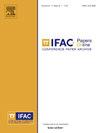Using Benford’s Law for analysis of the electroencephalogram
Q3 Engineering
引用次数: 0
Abstract
We investigated the first-digit distribution of simulated and real EEG signals recorded during wakefulness and various sleep stages. Furthermore, we examined how variables such as noise or patient age influence the first-digit distribution and affect its conformity with Benford’s Law. Simulated 1/f noise episodes, which serve as proxies for EEG data, were generated with varying spectral exponents to explore how these changes influence the first-digit distribution. Additionally, we analyzed sleep EEG data from an open-source database to compare the first-digit distributions across different sleep stages, particularly focusing on N3 sleep, which shares similarities with EEG patterns observed under general anesthesia.
Our results demonstrate that the first-digit distribution is influenced by the investigated features, i.e., spectral exponent, vigilance state, and age. Deviations from wakefulness cause deviations from the Benford distribution. Moreover, age-related variations in EEG data may lead to changes in first-digit distributions, potentially offering new insights into how aging affects brain activity. These findings suggest that applying Benford’s Law to EEG analysis could complement existing methods for patient monitoring. The results from our investigation justify the next step of applying this method to anesthesia data.
用本福德定律分析脑电图
我们研究了在清醒和不同睡眠阶段记录的模拟和真实脑电图信号的第一位数分布。此外,我们研究了诸如噪声或患者年龄等变量如何影响第一位数分布并影响其与本福德定律的一致性。模拟1/f噪声集,作为EEG数据的代理,产生不同的频谱指数,以探索这些变化如何影响第一位数分布。此外,我们分析了来自开源数据库的睡眠脑电图数据,比较了不同睡眠阶段的第一位数分布,特别关注N3睡眠,这与全身麻醉下观察到的脑电图模式有相似之处。我们的研究结果表明,第一位数分布受所研究的特征,即频谱指数,警戒状态和年龄的影响。偏离清醒状态导致偏离本福德分布。此外,脑电图数据中与年龄相关的变化可能导致第一指分布的变化,这可能为衰老如何影响大脑活动提供新的见解。这些发现表明,将本福德定律应用于脑电图分析可以补充现有的患者监测方法。我们的研究结果证明了将这种方法应用于麻醉数据的下一步。
本文章由计算机程序翻译,如有差异,请以英文原文为准。
求助全文
约1分钟内获得全文
求助全文
来源期刊

IFAC-PapersOnLine
Engineering-Control and Systems Engineering
CiteScore
1.70
自引率
0.00%
发文量
1122
期刊介绍:
All papers from IFAC meetings are published, in partnership with Elsevier, the IFAC Publisher, in theIFAC-PapersOnLine proceedings series hosted at the ScienceDirect web service. This series includes papers previously published in the IFAC website.The main features of the IFAC-PapersOnLine series are: -Online archive including papers from IFAC Symposia, Congresses, Conferences, and most Workshops. -All papers accepted at the meeting are published in PDF format - searchable and citable. -All papers published on the web site can be cited using the IFAC PapersOnLine ISSN and the individual paper DOI (Digital Object Identifier). The site is Open Access in nature - no charge is made to individuals for reading or downloading. Copyright of all papers belongs to IFAC and must be referenced if derivative journal papers are produced from the conference papers. All papers published in IFAC-PapersOnLine have undergone a peer review selection process according to the IFAC rules.
 求助内容:
求助内容: 应助结果提醒方式:
应助结果提醒方式:


